sport mode BMW 740IL 2001 E38 Level Control System Manual
[x] Cancel search | Manufacturer: BMW, Model Year: 2001, Model line: 740IL, Model: BMW 740IL 2001 E38Pages: 57, PDF Size: 1.89 MB
Page 13 of 57
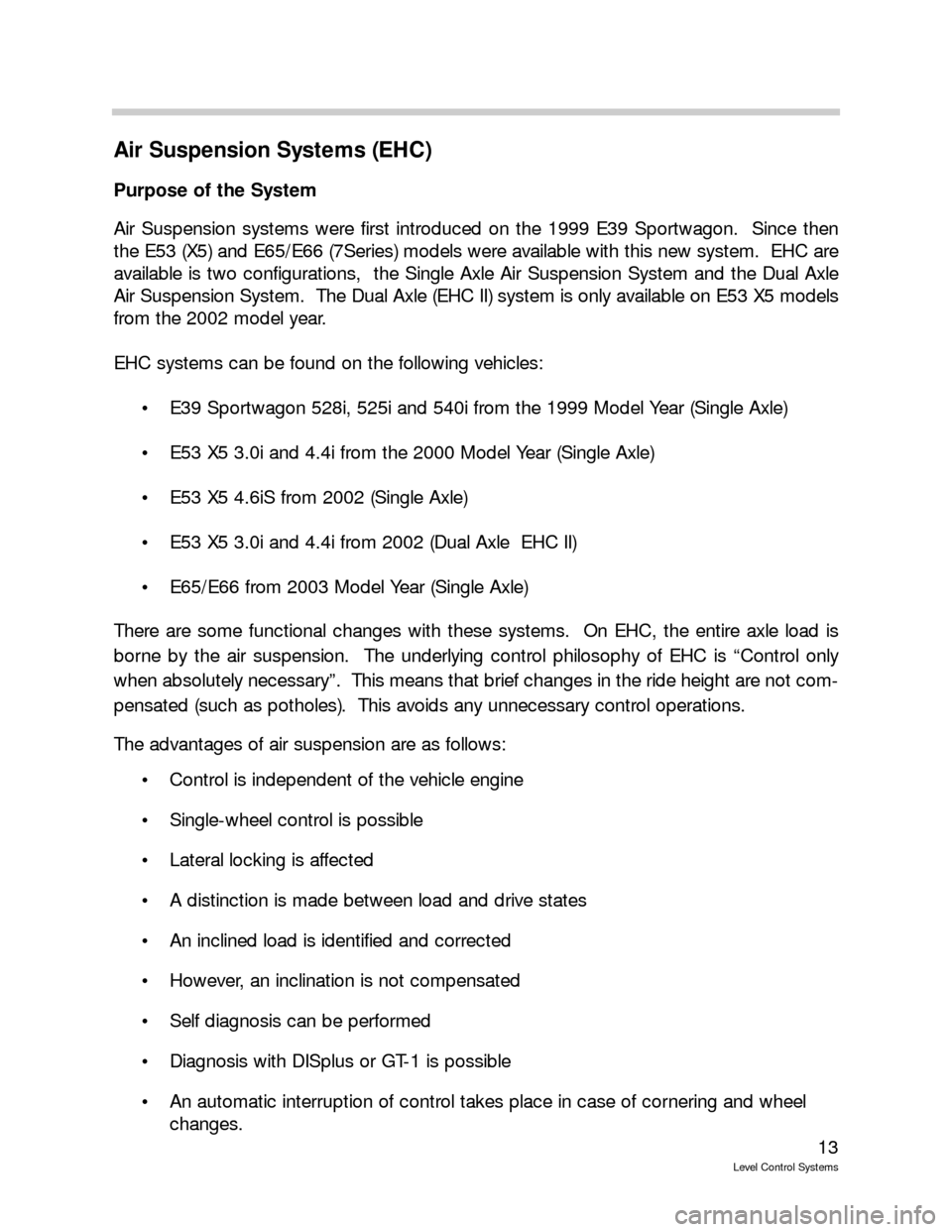
13
Level Control Systems
Air Suspension Systems (EHC)
Purpose of the System
Air Suspension systems were first introduced on the 1999 E39 Sportwagon. Since then
the E53 (X5) and E65/E66 (7Series) models were available with this new system. EHC are
available is two configurations, the Single Axle Air Suspension System and the Dual Axle
Air Suspension System. The Dual Axle (EHC II) system is only available on E53 X5 models
from the 2002 model year.
EHC systems can be found on the following vehicles:
E39 Sportwagon 528i, 525i and 540i from the 1999 Model Year (Single Axle)
E53 X5 3.0i and 4.4i from the 2000 Model Year (Single Axle)
E53 X5 4.6iS from 2002 (Single Axle)
E53 X5 3.0i and 4.4i from 2002 (Dual Axle EHC II)
E65/E66 from 2003 Model Year (Single Axle)
There are some functional changes with these systems. On EHC, the entire axle load is
borne by the air suspension. The underlying control philosophy of EHC is “Control only
when absolutely necessary”. This means that brief changes in the ride height are not com-
pensated (such as potholes). This avoids any unnecessary control operations.
The advantages of air suspension are as follows:
Control is independent of the vehicle engine
Single-wheel control is possible
Lateral locking is affected
A distinction is made between load and drive states
An inclined load is identified and corrected
However, an inclination is not compensated
Self diagnosis can be performed
Diagnosis with DISplus or GT-1 is possible
An automatic interruption of control takes place in case of cornering and wheel
changes.
Page 17 of 57
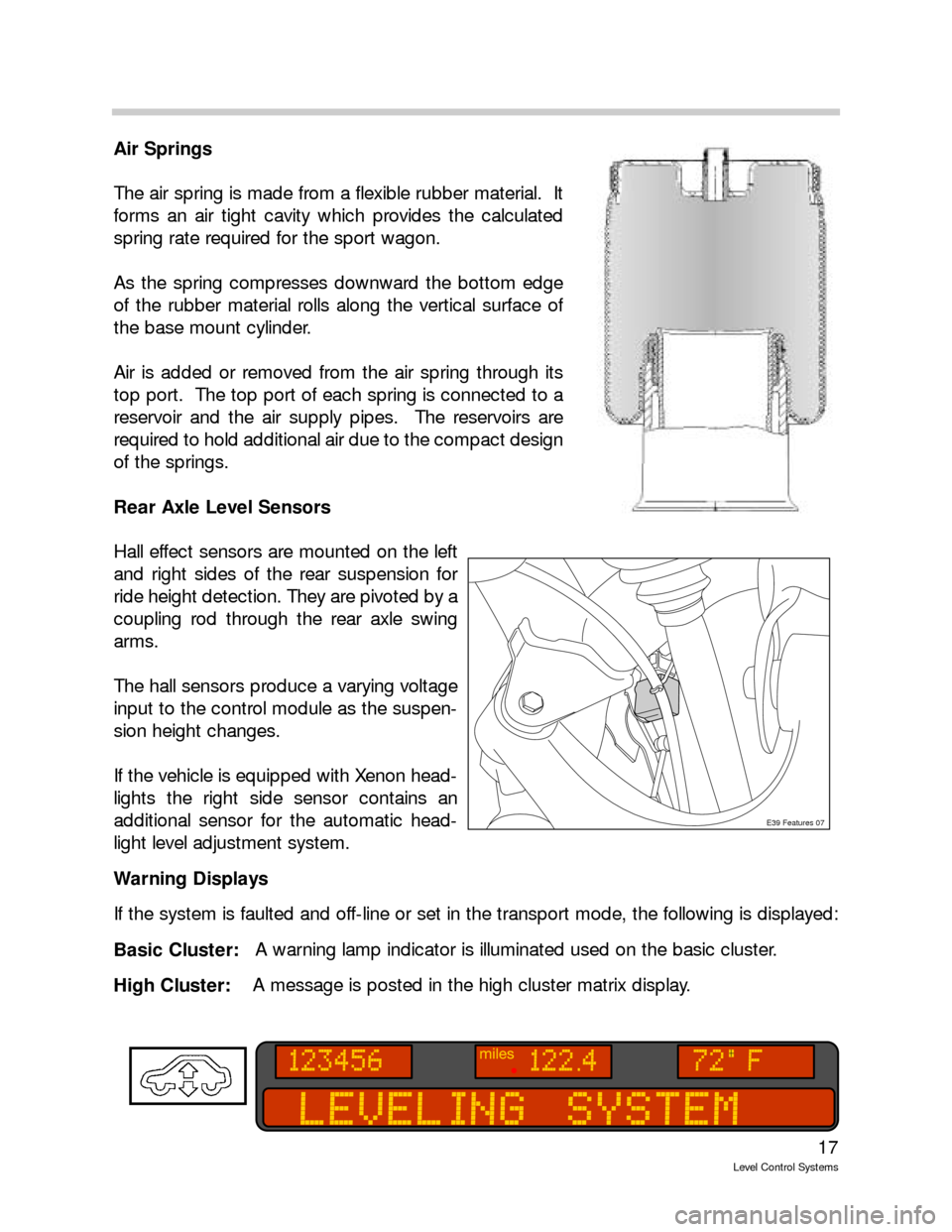
17
Level Control Systems
Air Springs
The air spring is made from a flexible rubber material. It
forms an air tight cavity which provides the calculated
spring rate required for the sport wagon.
As the spring compresses downward the bottom edge
of the rubber material rolls along the vertical surface of
the base mount cylinder.
Air is added or removed from the air spring through its
top port. The top port of each spring is connected to a
reservoir and the air supply pipes. The reservoirs are
required to hold additional air due to the compact design
of the springs.
Rear Axle Level Sensors
Hall effect sensors are mounted on the left
and right sides of the rear suspension for
ride height detection. They are pivoted by a
coupling rod through the rear axle swing
arms.
The hall sensors produce a varying voltage
input to the control module as the suspen-
sion height changes.
If the vehicle is equipped with Xenon head-
lights the right side sensor contains an
additional sensor for the automatic head-
light level adjustment system.
Warning Displays
If the system is faulted and off-line or set in the transport mode, the following is displayed:
Basic Cluster:A warning lamp indicator is illuminated used on the basic cluster.
High Cluster: A message is posted in the high cluster matrix display.
E39 Features 07
Page 21 of 57
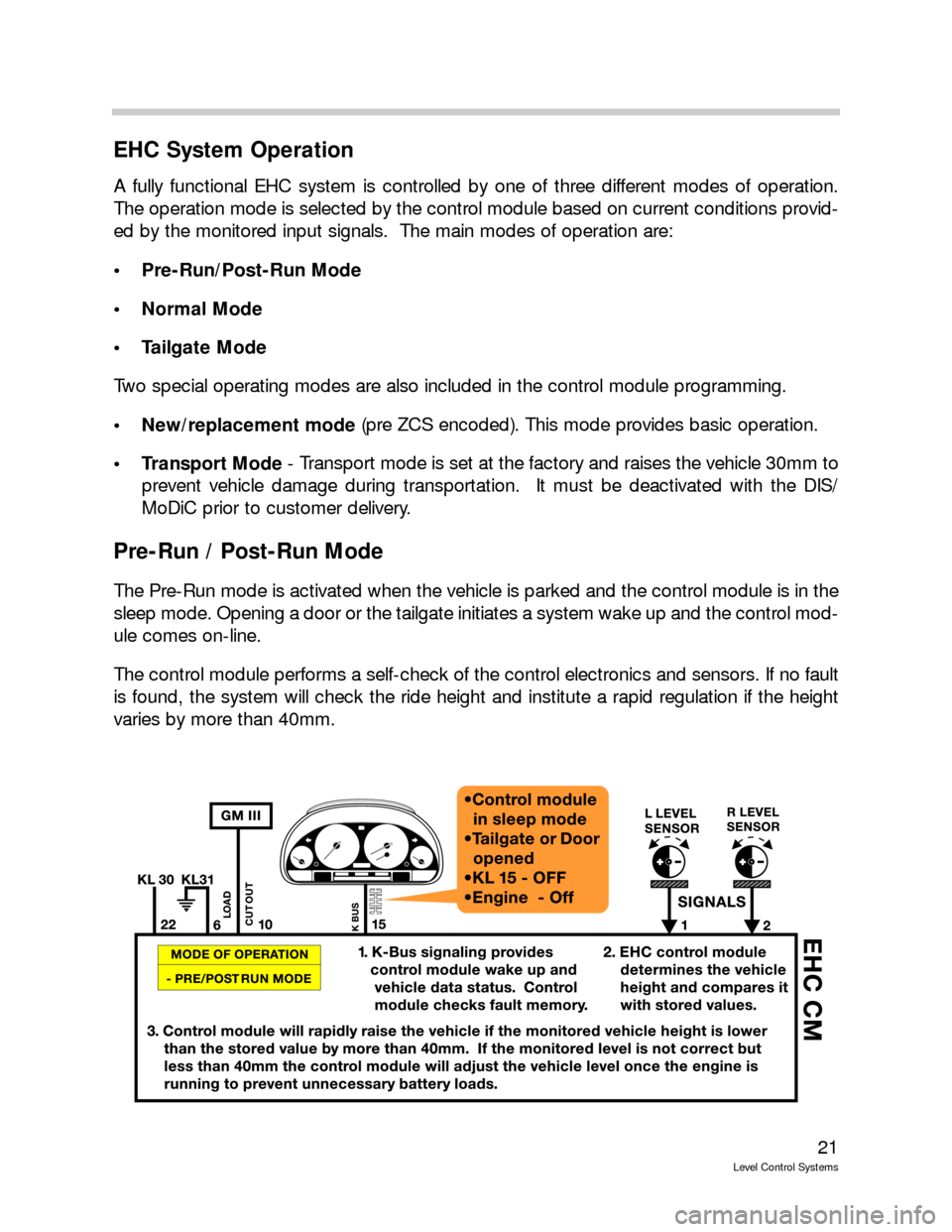
21
Level Control Systems
EHC System Operation
A fully functional EHC system is controlled by one of three different modes of operation.
The operation mode is selected by the control module based on current conditions provid-
ed by the monitored input signals. The main modes of operation are:
• Pre-Run/Post-Run Mode
Normal Mode
Tailgate Mode
Two special operating modes are also included in the control module programming.
New/replacement mode(pre ZCS encoded). This mode provides basic operation.
Transport Mode - Transport mode is set at the factory and raises the vehicle 30mm to
prevent vehicle damage during transportation. It must be deactivated with the DIS/
MoDiC prior to customer delivery.
Pre-Run / Post-Run Mode
The Pre-Run mode is activated when the vehicle is parked and the control module is in the
sleep mode. Opening a door or the tailgate initiates a system wake up and the control mod-
ule comes on-line.
The control module performs a self-check of the control electronics and sensors. If no fault
is found, the system will check the ride height and institute a rapid regulation if the height
varies by more than 40mm.
Page 23 of 57
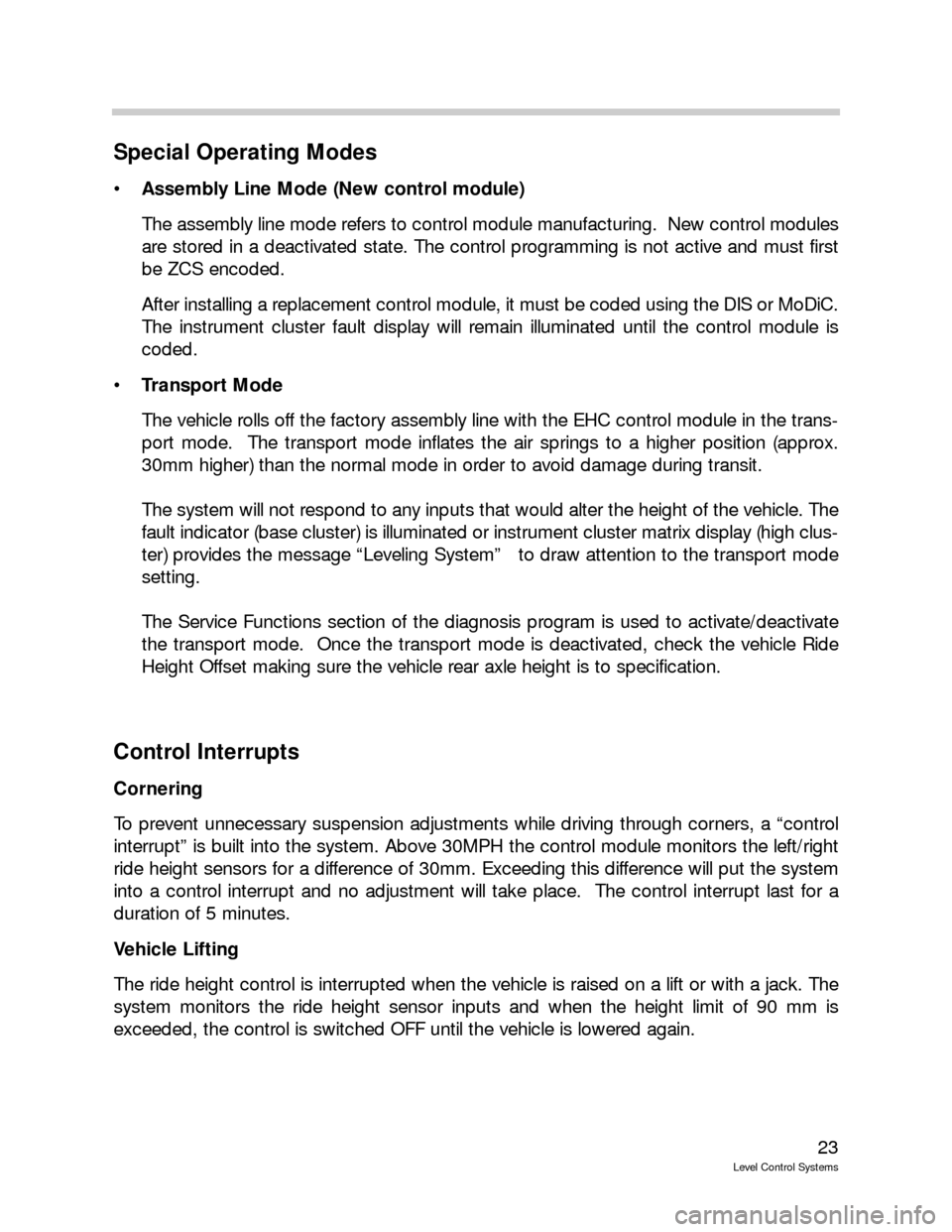
23
Level Control Systems
Special Operating Modes
Assembly Line Mode (New control module)
The assembly line mode refers to control module manufacturing. New control modules
are stored in a deactivated state. The control programming is not active and must first
be ZCS encoded.
After installing a replacement control module, it must be coded using the DIS or MoDiC.
The instrument cluster fault display will remain illuminated until the control module is
coded.
Transport Mode
The vehicle rolls off the factory assembly line with the EHC control module in the trans-
port mode. The transport mode inflates the air springs to a higher position (approx.
30mm higher) than the normal mode in order to avoid damage during transit.
The system will not respond to any inputs that would alter the height of the vehicle. The
fault indicator (base cluster) is illuminated or instrument cluster matrix display (high clus-
ter) provides the message “Leveling System” to draw attention to the transport mode
setting.
The Service Functions section of the diagnosis program is used to activate/deactivate
the transport mode. Once the transport mode is deactivated, check the vehicle Ride
Height Offset making sure the vehicle rear axle height is to specification.
Control Interrupts
Cornering
To prevent unnecessary suspension adjustments while driving through corners, a “control
interrupt” is built into the system. Above 30MPH the control module monitors the left/right
ride height sensors for a difference of 30mm. Exceeding this difference will put the system
into a control interrupt and no adjustment will take place. The control interrupt last for a
duration of 5 minutes.
Vehicle Lifting
The ride height control is interrupted when the vehicle is raised on a lift or with a jack. The
system monitors the ride height sensor inputs and when the height limit of 90 mm is
exceeded, the control is switched OFF until the vehicle is lowered again.
Page 25 of 57
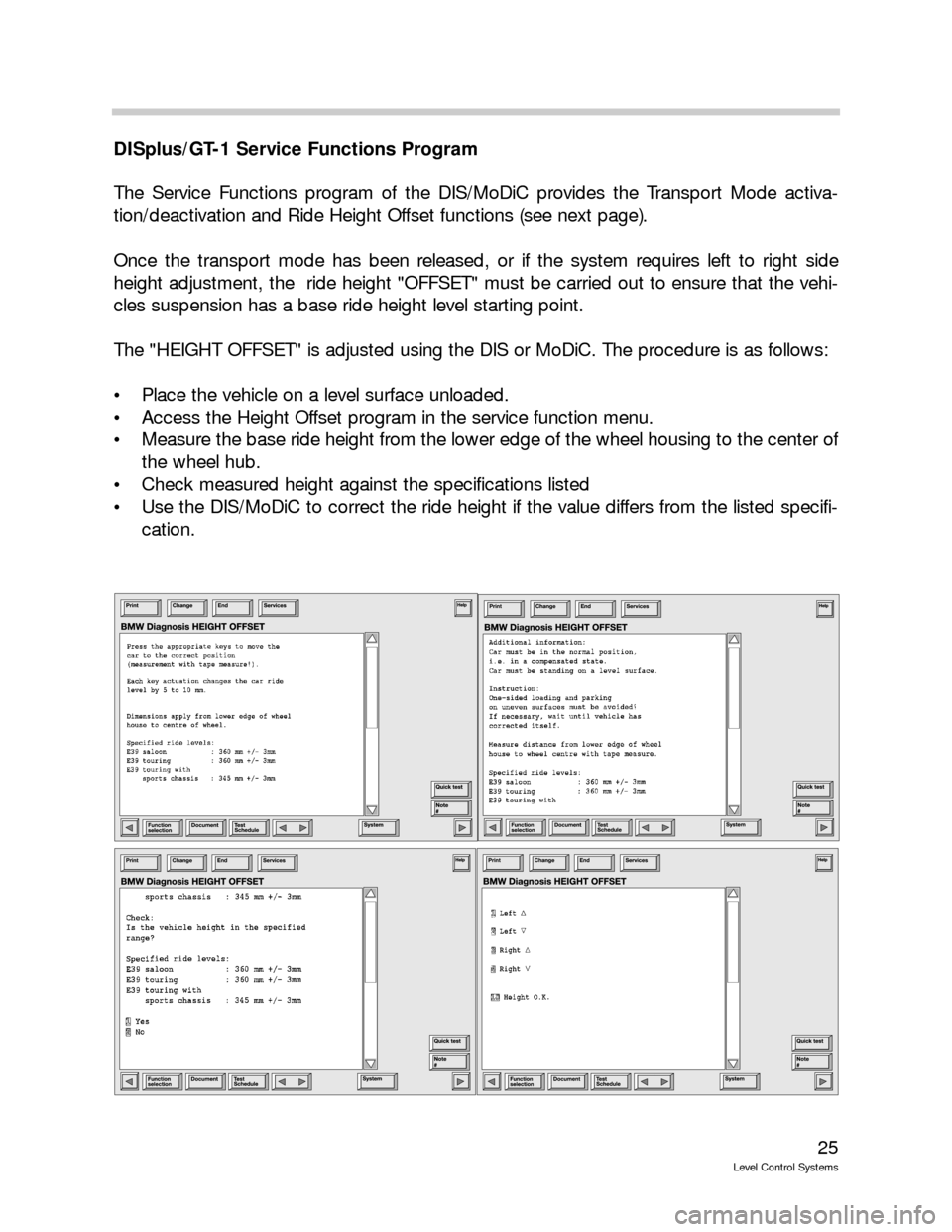
25
Level Control Systems
DISplus/GT-1 Service Functions Program
The Service Functions program of the DIS/MoDiC provides the Transport Mode activa-
tion/deactivation and Ride Height Offset functions (see next page).
Once the transport mode has been released, or if the system requires left to right side
height adjustment, the ride height "OFFSET" must be carried out to ensure that the vehi-
cles suspension has a base ride height level starting point.
The "HEIGHT OFFSET" is adjusted using the DIS or MoDiC. The procedure is as follows:
Place the vehicle on a level surface unloaded.
Access the Height Offset program in the service function menu.
Measure the base ride height from the lower edge of the wheel housing to the center of
the wheel hub.
Check measured height against the specifications listed
Use the DIS/MoDiC to correct the ride height if the value differs from the listed specifi-
cation.
Page 39 of 57
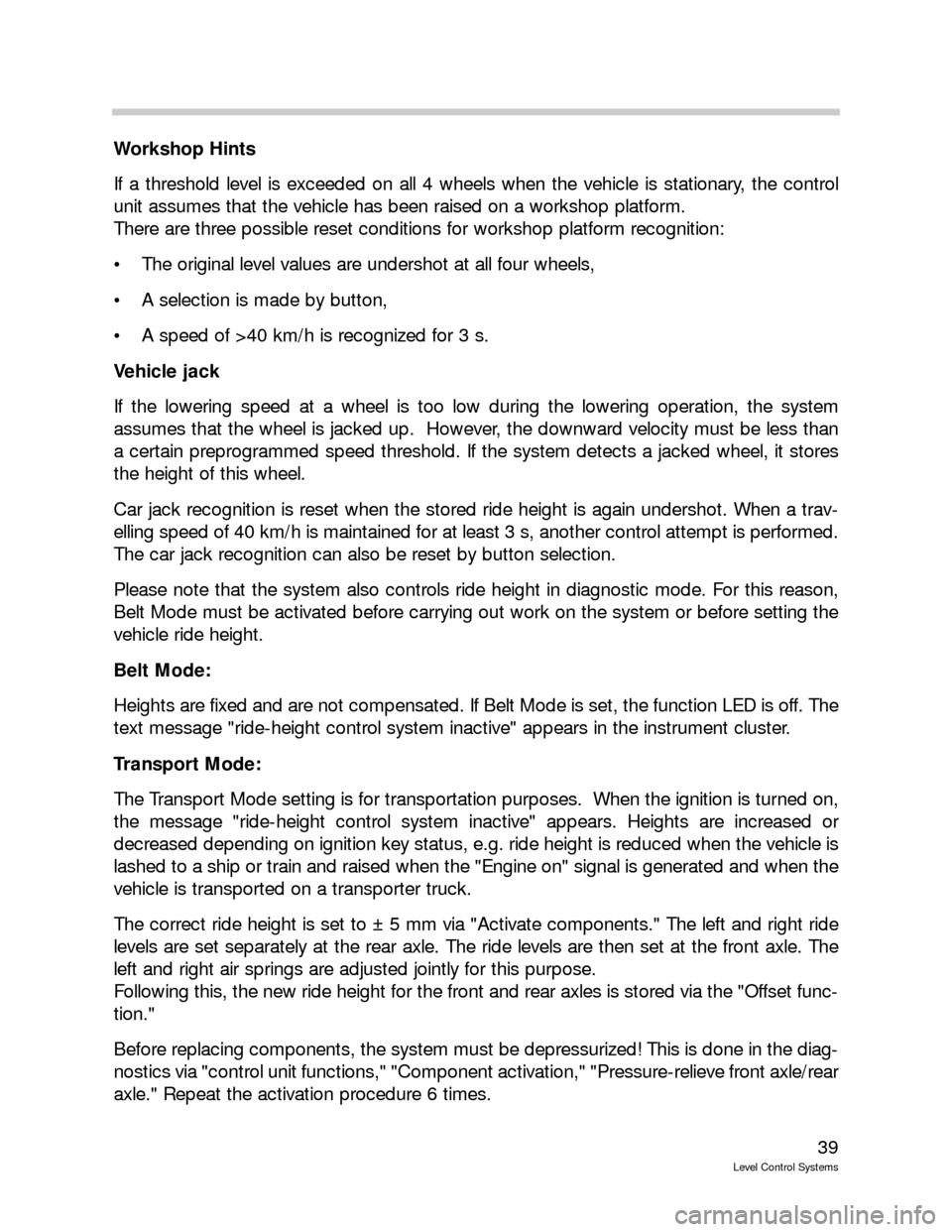
39
Level Control Systems
Workshop Hints
If a threshold level is exceeded on all 4 wheels when the vehicle is stationary, the control
unit assumes that the vehicle has been raised on a workshop platform.
There are three possible reset conditions for workshop platform recognition:
The original level values are undershot at all four wheels,
A selection is made by button,
A speed of >40 km/h is recognized for 3 s.
Vehicle jack
If the lowering speed at a wheel is too low during the lowering operation, the system
assumes that the wheel is jacked up. However, the downward velocity must be less than
a certain preprogrammed speed threshold. If the system detects a jacked wheel, it stores
the height of this wheel.
Car jack recognition is reset when the stored ride height is again undershot. When a trav-
elling speed of 40 km/h is maintained for at least 3 s, another control attempt is performed.
The car jack recognition can also be reset by button selection.
Please note that the system also controls ride height in diagnostic mode. For this reason,
Belt Mode must be activated before carrying out work on the system or before setting the
vehicle ride height.
Belt Mode:
Heights are fixed and are not compensated. If Belt Mode is set, the function LED is off. The
text message "ride-height control system inactive" appears in the instrument cluster.
Transport Mode:
The Transport Mode setting is for transportation purposes. When the ignition is turned on,
the message "ride-height control system inactive" appears. Heights are increased or
decreased depending on ignition key status, e.g. ride height is reduced when the vehicle is
lashed to a ship or train and raised when the "Engine on" signal is generated and when the
vehicle is transported on a transporter truck.
The correct ride height is set to ± 5 mm via "Activate components." The left and right ride
levels are set separately at the rear axle. The ride levels are then set at the front axle. The
left and right air springs are adjusted jointly for this purpose.
Following this, the new ride height for the front and rear axles is stored via the "Offset func-
tion."
Before replacing components, the system must be depressurized! This is done in the diag-
nostics via "control unit functions," "Component activation," "Pressure-relieve front axle/rear
axle." Repeat the activation procedure 6 times.
Page 46 of 57
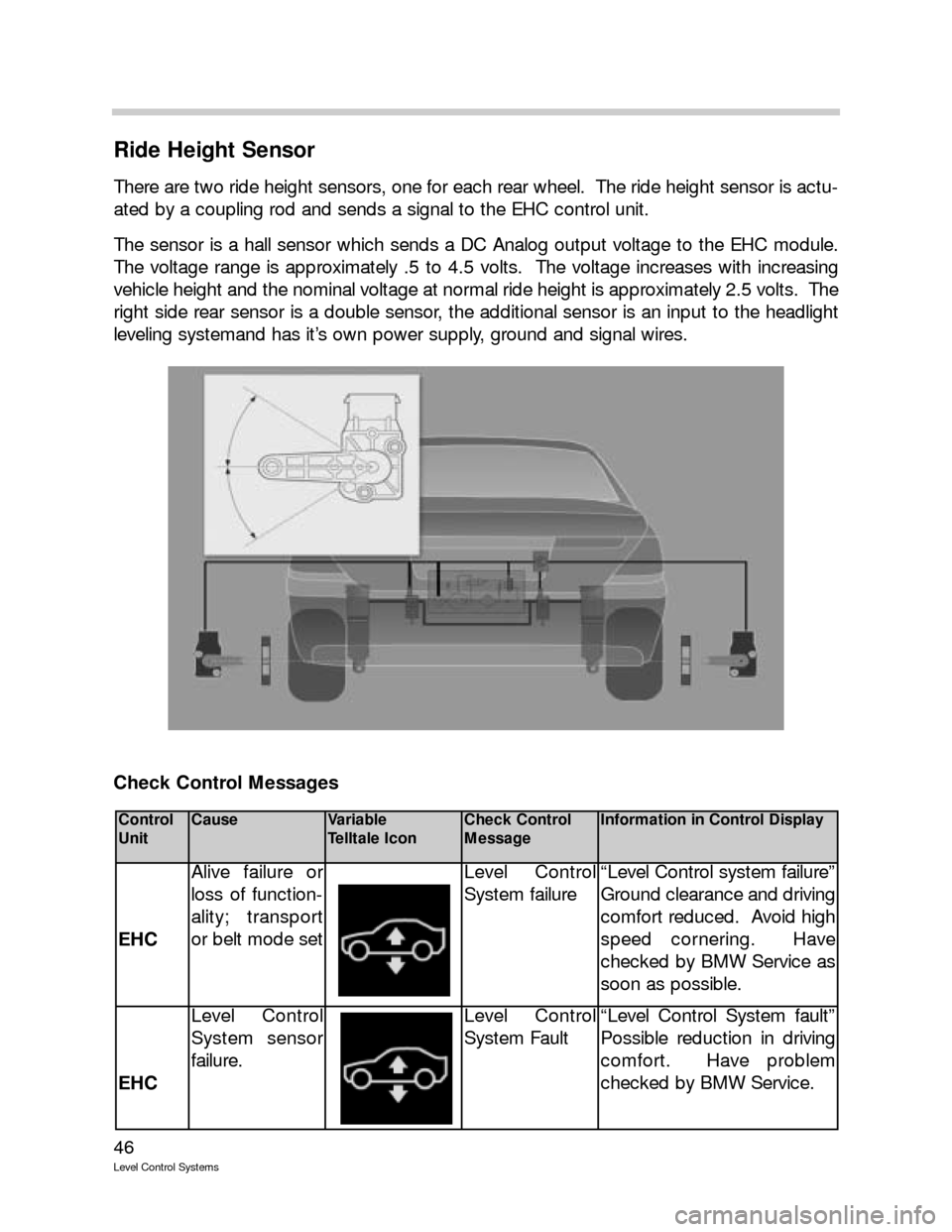
46
Level Control Systems
Ride Height Sensor
There are two ride height sensors, one for each rear wheel. The ride height sensor is actu-
ated by a coupling rod and sends a signal to the EHC control unit.
The sensor is a hall sensor which sends a DC Analog output voltage to the EHC module.
The voltage range is approximately .5 to 4.5 volts. The voltage increases with increasing
vehicle height and the nominal voltage at normal ride height is approximately 2.5 volts. The
right side rear sensor is a double sensor, the additional sensor is an input to the headlight
leveling systemand has it’s own power supply, ground and signal wires.
Check Control Messages
Control
UnitCauseVariable
Telltale IconCheck Control
MessageInformation in Control Display
EHC
Alive failure or
loss of function-
ality; transport
or belt mode setLevel Control
System failure“Level Control system failure”
Ground clearance and driving
comfort reduced. Avoid high
speed cornering. Have
checked by BMW Service as
soon as possible.
EHC
Level Control
System sensor
failure.Level Control
System Fault“Level Control System fault”
Possible reduction in driving
comfort. Have problem
checked by BMW Service.
Page 52 of 57
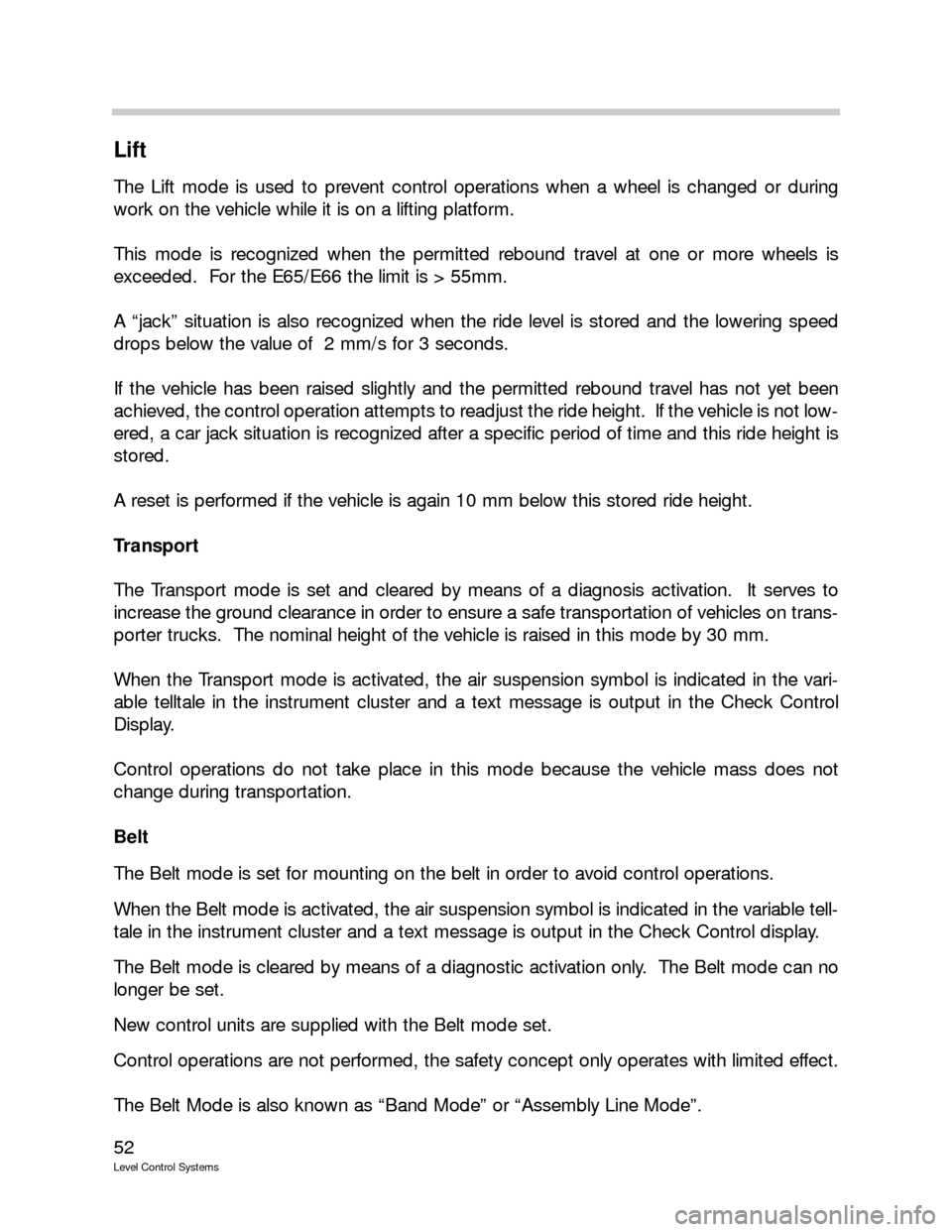
52
Level Control Systems
Lift
The Lift mode is used to prevent control operations when a wheel is changed or during
work on the vehicle while it is on a lifting platform.
This mode is recognized when the permitted rebound travel at one or more wheels is
exceeded. For the E65/E66 the limit is > 55mm.
A “jack” situation is also recognized when the ride level is stored and the lowering speed
drops below the value of 2 mm/s for 3 seconds.
If the vehicle has been raised slightly and the permitted rebound travel has not yet been
achieved, the control operation attempts to readjust the ride height. If the vehicle is not low-
ered, a car jack situation is recognized after a specific period of time and this ride height is
stored.
A reset is performed if the vehicle is again 10 mm below this stored ride height.
Transport
The Transport mode is set and cleared by means of a diagnosis activation. It serves to
increase the ground clearance in order to ensure a safe transportation of vehicles on trans-
porter trucks. The nominal height of the vehicle is raised in this mode by 30 mm.
When the Transport mode is activated, the air suspension symbol is indicated in the vari-
able telltale in the instrument cluster and a text message is output in the Check Control
Display.
Control operations do not take place in this mode because the vehicle mass does not
change during transportation.
Belt
The Belt mode is set for mounting on the belt in order to avoid control operations.
When the Belt mode is activated, the air suspension symbol is indicated in the variable tell-
tale in the instrument cluster and a text message is output in the Check Control display.
The Belt mode is cleared by means of a diagnostic activation only. The Belt mode can no
longer be set.
New control units are supplied with the Belt mode set.
Control operations are not performed, the safety concept only operates with limited effect.
The Belt Mode is also known as “Band Mode” or “Assembly Line Mode”.
Page 55 of 57
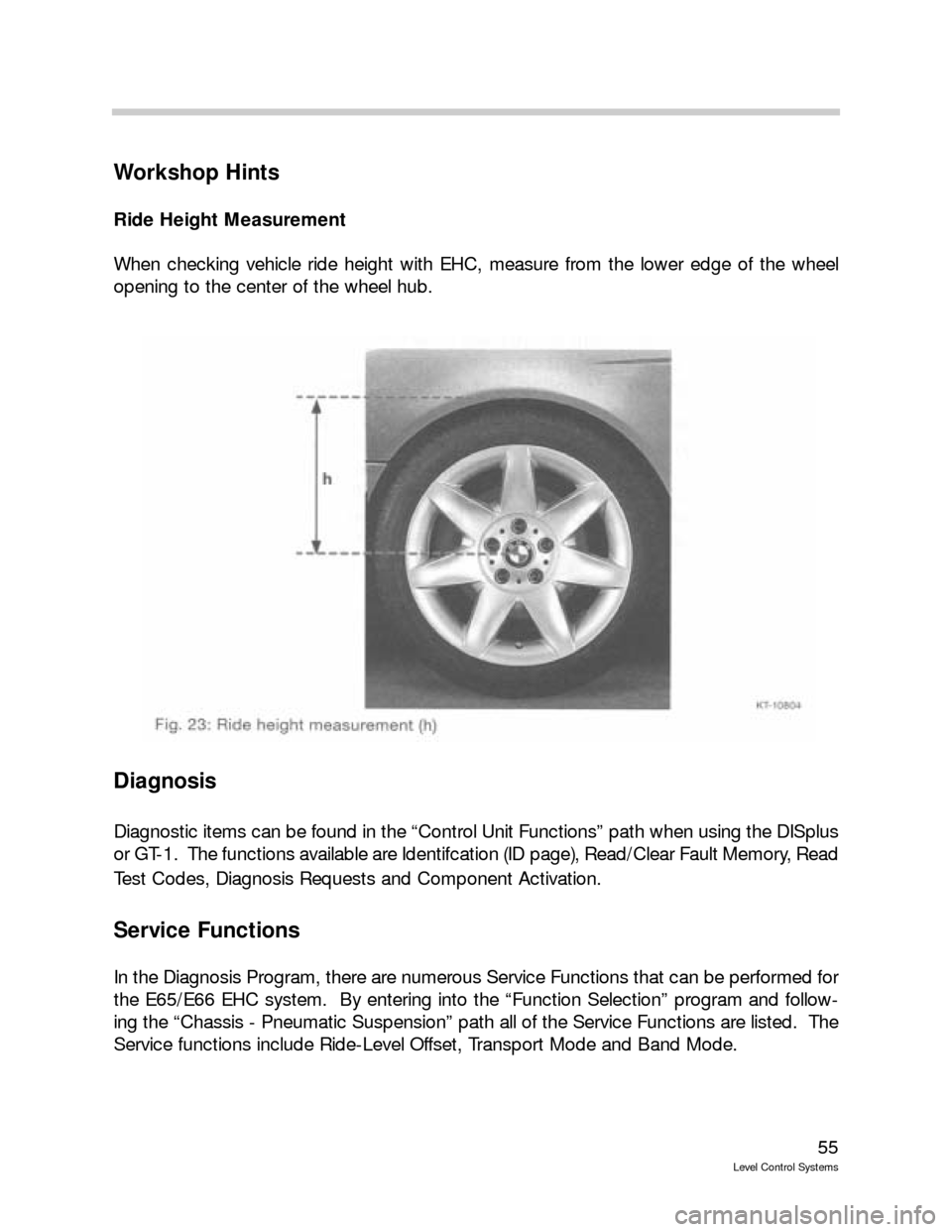
55
Level Control Systems
Workshop Hints
Ride Height Measurement
When checking vehicle ride height with EHC, measure from the lower edge of the wheel
opening to the center of the wheel hub.
Diagnosis
Diagnostic items can be found in the “Control Unit Functions” path when using the DISplus
or GT-1. The functions available are Identifcation (ID page), Read/Clear Fault Memory, Read
Test Codes, Diagnosis Requests and Component Activation.
Service Functions
In the Diagnosis Program, there are numerous Service Functions that can be performed for
the E65/E66 EHC system. By entering into the “Function Selection” program and follow-
ing the “Chassis - Pneumatic Suspension” path all of the Service Functions are listed. The
Service functions include Ride-Level Offset, Transport Mode and Band Mode.